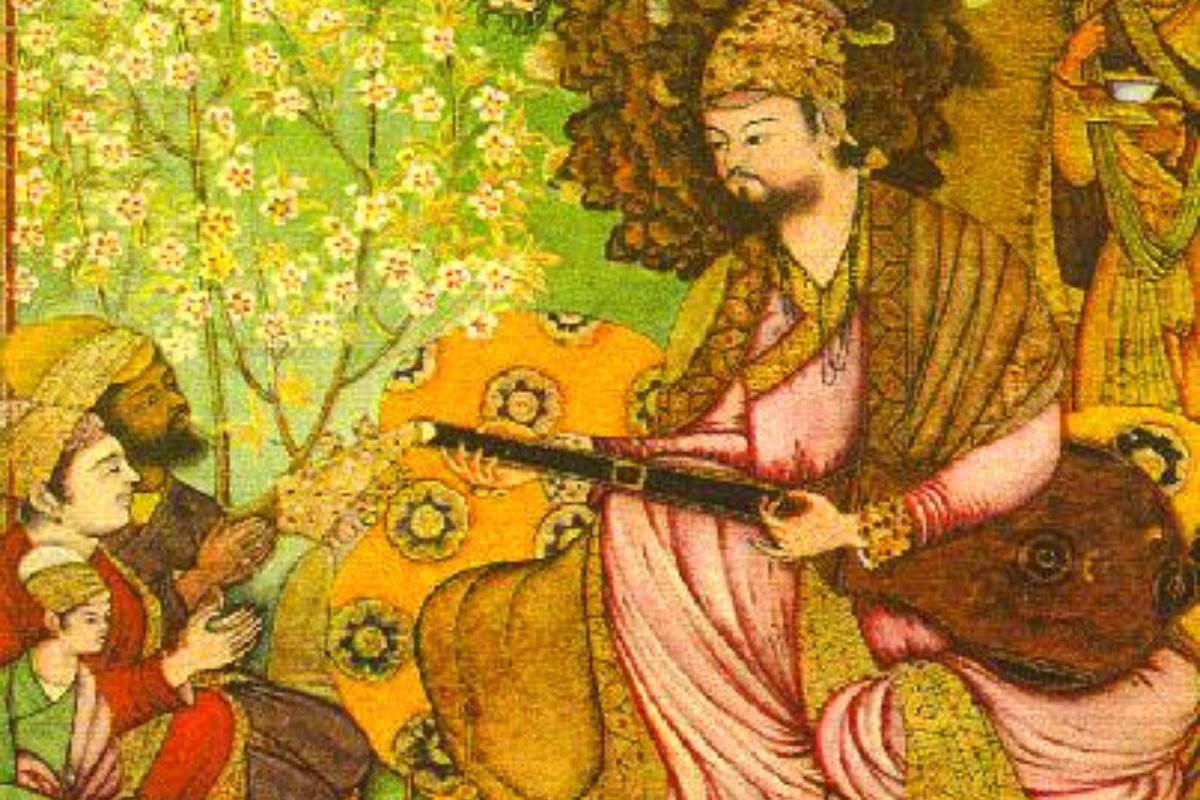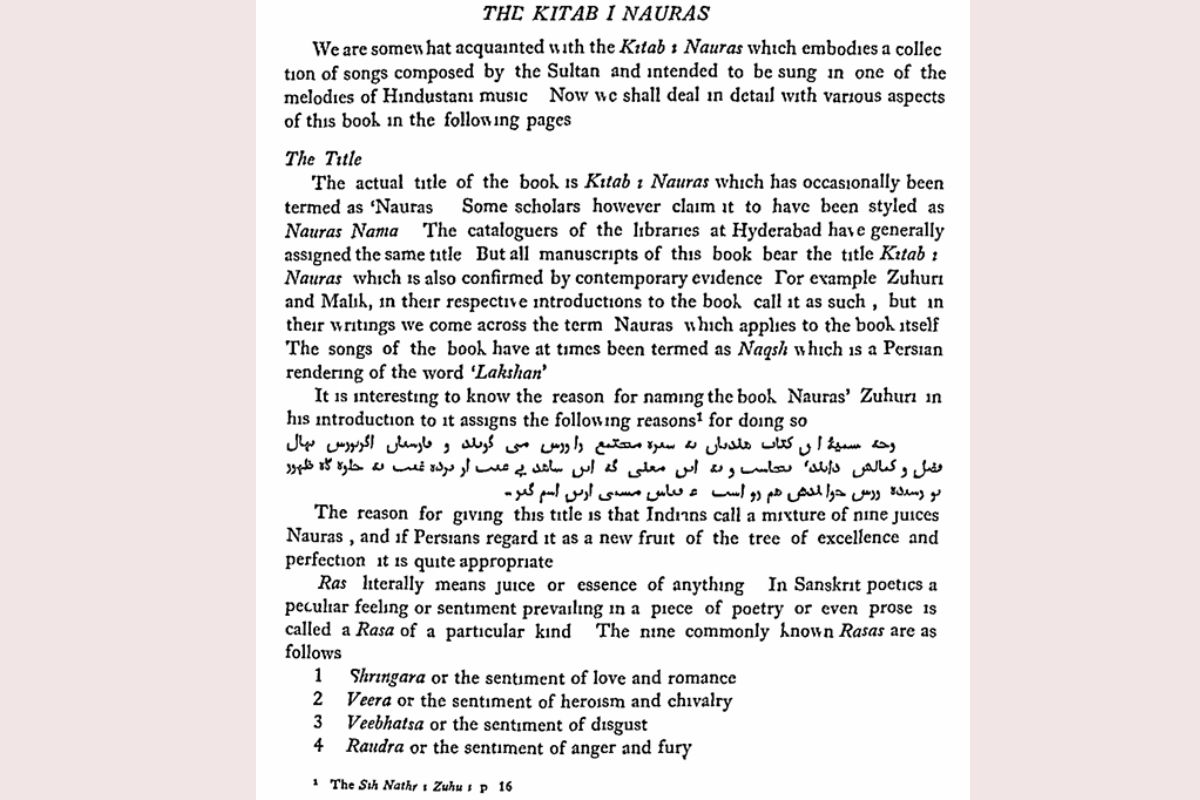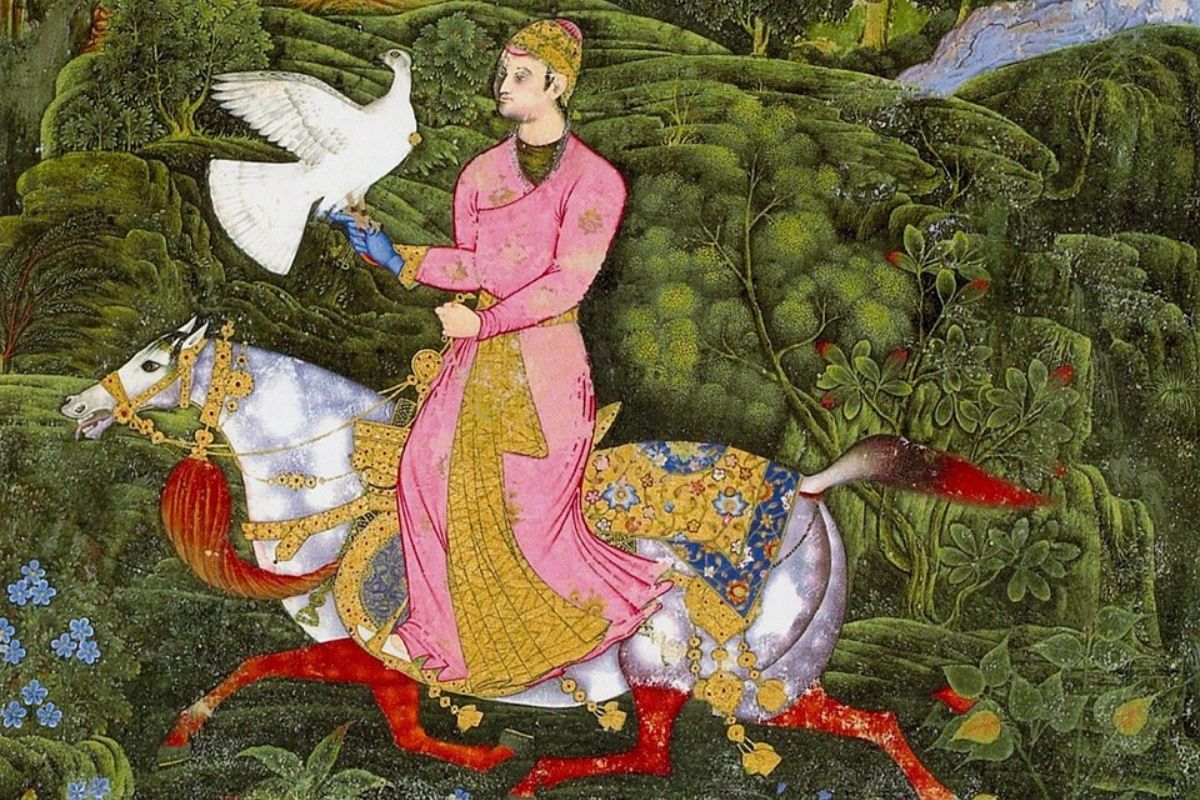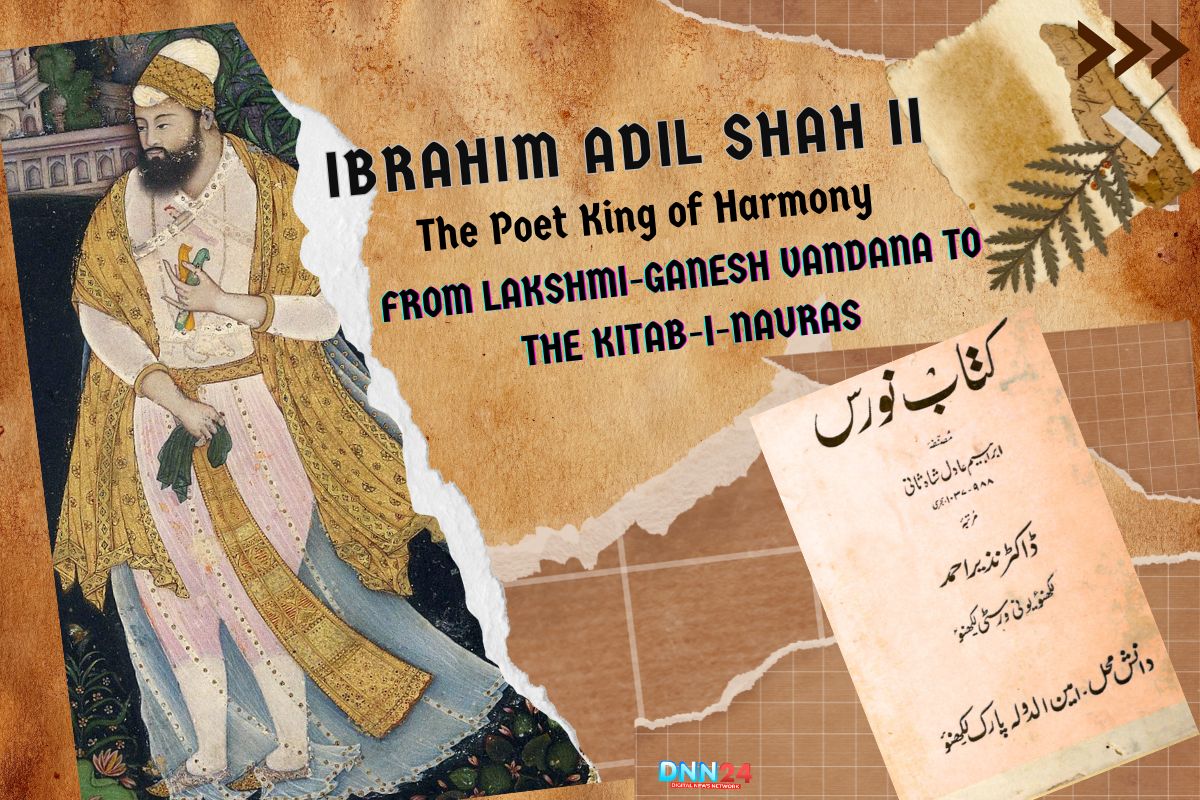Ibrahim Adil Shah II was born in 1570 into the legendary Adil Shahi family, which governed the Sultanate of Bijapur in the Deccan area of India. His father, Tahamasp, and mother, Haji Badi Sahiba Begum, were members of a family that had established themselves as a prominent force in South India. Ibrahim gained the kingdom at a young age, about nine years old, after the death of his predecessor, Ali Adil Shah I. Though he was crowned in 1580, his true reign started in earnest in 1590 as he evolved into a good leader. From the onset, Ibrahim was known for his brilliance, sensitivity, and creativity.
His reign was the golden period of the Adil Shahi dynasty, with Bijapur reaching its greatest geographical extent, spanning as far south as Mysore. The Sultan’s early years were molded by the cosmopolitan climate of Bijapur, a metropolis that was a melting pot of Persian, Marathi, Kannada, and Deccani civilizations. This diversified milieu significantly shaped his perspective, establishing a strong passion for the arts, music, and literature. Ibrahim was not just a king but also an artist, poet, musician, and a rich supporter of artistic abilities. His court became a magnet for artists, poets, singers, and intellectuals throughout the subcontinent, making Bijapur a bustling hub of cultural fusion.
Lakshmi-Ganesh Vandana: Ibrahim Adil Shah II’s Devotion Beyond Boundaries
One of the most notable characteristics of Ibrahim Adil Shah II’s rule was his unreserved embracing of Hindu customs, notably his worship of deities like Lakshmi and Ganesh. Unlike many of his contemporaries, Ibrahim did not consider religious differences as walls but as bridges to deeper understanding. In his poetry and musical works, he regularly invoked Hindu gods with Islamic characters, creating a unique religious tapestry that mirrored the eclectic spirit of his realm. His Kitab-i-Nauras, a famed collection of songs, starts with a plea to Saraswati, the Hindu goddess of learning. He also produced poetry honoring Lakshmi and Ganesh, mixing conventional Hindu images with Islamic spiritual ideas.
Ibrahim’s farms, or royal decrees, typically started with invocations to Hindu deities, a relatively rare behavior for a Muslim monarch of his day. This syncretic approach was symbolic and purposeful in establishing unity among his people, who belonged to numerous faith groupings. Some orthodox elements in his court accused him of covertly practicing Hinduism, but Ibrahim remained consistent in his dedication to religious pluralism. His devotion to Lakshmi and Ganesh was personal and political, as a strong declaration of togetherness in a region typically split by sectarian warfare.
Why Ibrahim Adil Shah II Wrote Kitab-i-Nauras and How He Created It
Ibrahim Adil Shah II’s biggest masterpiece, the Kitab-i-Nauras (Book of Nine Rasas), is a monument to his cultural and spiritual fusion ideal. Written in Dakhani, an early form of Urdu, the book consists of 59 poems and 17 couplets, each addressing one of the nine traditional ragas or emotional essences fundamental to Indian aesthetics. Ibrahim’s court poet, Muhammad Zuhuri, stated that the Sultan created this poem to explain the rich Indian philosophy of rasas to individuals versed solely with Persian literary traditions. The Kitab-i-Nauras starts with a hymn to Saraswati, reflecting the Sultan’s appreciation for wisdom and study, irrespective of religious affiliation.
Ibrahim’s creative process was extremely absorbing; he relied upon his broad knowledge of music, poetry, and Indian philosophy, integrating them effortlessly with Persian traditions. The language of the book is heavily Sanskritised, demonstrating his enthusiasm for Sanskrit literature and his aim to reach a larger audience. The songs glorify Hindu goddesses like Saraswati and Ganesh and Islamic personalities such as the Prophet Muhammad and Sufi saints. Ibrahim aspired to promote peace and harmony with this work, employing music and poetry for spiritual and cultural conversation. The Kitab-i-Nauras is a pioneering example of cross-cultural literary success, representing the Sultan’s conviction in the transformational potential of art.
Ibrahim Adil Shah II Write-Ups: A Mosaic of Artistic Expression
The literary output of Ibrahim Adil Shah II stretches beyond the Kitab-i-Nauras, spanning a broad spectrum of poetry and musical writings. He was a prolific writer who utilized his writings to reflect his philosophical ideas, personal experiences, and creative objectives. Ibrahim’s poetry is recognized for its lyrical beauty, vivid imagery, and deep spiritual insights. He typically wrote about love, devotion, and the ephemeral aspect of life, which appealed to Hindu and Muslim audiences. His lyrics normally incorporated analogies borrowed from Indian mythology and environment, expressing his profound affinity to the region and its traditions.

In addition to his works, Ibrahim was noted for his encouragement of poets and intellectuals from many backgrounds. His court featured intellectuals like the Sanskrit scholar Vaman Pandit, whose presence significantly improved the intellectual life of Bijapur. Ibrahim’s write-ups were not restricted to theological or philosophical issues; he embraced everyday delights, such as his adoration for his pet elephant or treasured tambourine. This combination of the holy and the commonplace made his writings approachable and relevant, appealing to people from all walks of life. Ibrahim tried to overcome cultural gaps via his works and build a single identity among his people.
Inspiration from Sanskrit: Embracing India’s Ancient Wisdom
Ibrahim Adil Shah II’s relationship with Sanskrit was both deep and pioneering. At a period when Persian was the primary language of the courts in the Deccan, Ibrahim opted to immerse himself in the study of Sanskrit, the traditional language of Hindu philosophy and literature. His mastery of Sanskrit was generally considered superior to his comprehension of Persian, a tribute to his intellectual curiosity and openness to new ideas. This intense admiration for Sanskrit is evident in the highly Sanskritised language of his Kitab-i-Nauras and in the titles he assumed, such as “Jagatguru” (World Teacher).
Ibrahim’s passion with Sanskrit extended to his support of professors and poets who were linguistic experts. He welcomed Vaman Pandit, a prominent Sanskrit scholar, to his court and promoted studying and interpreting Sanskrit works. Ibrahim’s appreciation of Sanskrit was not only intellectual; it mirrored his greater vision of cultural synthesis. By infusing Sanskritic aspects into his writings and court culture, he attempted to establish a new idiom transcending religious and linguistic divides. His efforts contributed immensely to blooming a distinctly Indian literary and artistic culture in the Deccan that honored variety and mutual tolerance.
Ibrahim Adil Shah II’s Famous Writings: The Legacy of Kitab-i-Nauras and Beyond
The Kitab-i-Nauras is the most acclaimed of Ibrahim Adil Shah II’s literary works. This unique work is a compilation of songs and poetry that explore the complete range of human emotions, building upon the old Indian philosophy of nine races. What sets the Kitab-i-Nauras distinct is its seamless merging of Hindu and Islamic imagery, its use of highly Sanskritised Dakhani, and its worldwide message of love, peace, and harmony. The book’s opening hymn to Saraswati, its praises of Ganesh and other Hindu deities, and its invocations of Islamic saints and the Prophet Muhammad all represent Ibrahim’s inclusive worldview.

Beyond the Kitab-i-Nauras, Ibrahim’s legacy comprises various lyrical and musical pieces preserved in oral and written traditions. His sponsorship of the arts spread to painting, architecture, and music, with his court becoming a magnet for creative invention. Artists like Hashim, who subsequently found recognition at the Mughal court, started their careers under Ibrahim’s patronage. The Sultan’s passion for music inspired him to establish a new capital, Nauraspur, to honor the arts. Through his writings and patronage, Ibrahim left an unmistakable effect on the cultural landscape of the Deccan, influencing generations of artists and philosophers.
Lakshmi-Ganesh Vandana: A Sultan’s Devotional Syncretism
Ibrahim Adil Shah II’s devotion to Lakshmi and Ganesh was a personal spiritual practice and a public demonstration of his dedication to religious peace. His songs and poetry regularly invoked these deities, requesting their blessings for wealth, knowledge, and success. The Kitab-i-Nauras comprises various hymns and praises devoted to Lakshmi, the goddess of riches, and Ganesh, the remover of obstacles. These works are famous for their lyrical beauty and their use of traditional Hindu imagery, such as lotus flowers, elephants, and holy rivers.
Ibrahim’s spiritual syncretism was also visible in his court traditions, where Hindu and Muslim festivities were sometimes conducted. This mingling of traditions showed the Sultan’s view that all ways eventually lead to the same heavenly truth. By worshipping Lakshmi and Ganesh, Ibrahim hoped to build a shared spiritual legacy among his people, promoting mutual respect and understanding. His method was both inventive and bold, defying the orthodoxies of his period and establishing an example for future monarchs.
How Ibrahim Adil Shah II Inspired by Sanskrit: A Cultural Transformation
Ibrahim Adil Shah II’s inspiration from Sanskrit was revolutionary for himself and his kingdom’s cultural life. His intensive study of Sanskrit scriptures and his interaction with famous Sanskrit academics helped him to integrate the philosophical and aesthetic ideas of Indian heritage. This influence is evident in the language and structure of his Kitab-i-Nauras, which utilizes Sanskritic terminology, poetic forms, and thematic themes. Ibrahim’s use of Sanskrit names, such as “Jagatguru,” and his presentation of himself in Hindu legendary terms further indicate his involvement with India’s ancient knowledge.
He regarded Sanskrit not as a language of the “other” but as a common cultural treasure that might improve the lives of all his people. By fostering the study of Sanskrit and advocating its incorporation into courtly culture, Ibrahim worked to break down boundaries between diverse languages and religious groupings. His efforts helped form a new, syncretic cultural identity in the Deccan that valued variety while recognizing a shared ancestry. Therefore, Ibrahim’s inspiration fr, om Sanskrit,t became a catalyst for artistic regeneration and creativity.

Interesting Aspects of His Famous Writings
The works of Ibrahim Adil Shah II are remarkable not just for their literary excellence but also for their unique synthesis of many cultures. The Kitab-i-Nauras is noteworthy for examining the nine races, a notion drawn from ancient Indian aesthetics and its usage of Dakhani. This language reflects the combination of Persian, Arabic, and Indian characteristics. The book’s structure, alternating songs and couplets, reflects the rhythms of Indian classical music, while its subjects span from religious hymns to frivolous love songs and philosophical observations.
What makes Ibrahim’s works genuinely special is their universalism; they appeal to the common human experience, transcending religious, linguistic, and cultural divides. His ability to weave together Hindu and Islamic ideas, to celebrate both the holy and the daily, and to utilize poetry to promote peace and harmony defines him as one of the most innovative and visionary authors of his time. The lasting appeal of his works resides in their power to stimulate conversation and understanding among individuals of diverse origins.
His Views on Hindus and Muslims: A Vision of Harmony
His devotion to religious tolerance and cultural diversity molded Ibrahim Adil Shah II’s views on Hindus and Muslims. Although he belonged to Sunni Islam, Hindu philosophy and spirituality significantly affected him. He aggressively encouraged unity between the two populations, endowing temples, confirming the rights of Hindu pilgrims, and integrating Hindu deities into his royal symbols. Ibrahim’s court was an example of inclusion, with Hindus and Muslims occupying prominent posts and participating equally in the country’s cultural life. He felt music, poetry, and art could be potent agents for transcending religious barriers and building a common identity.
Ibrahim’s works reflect this worldview, as he extols the merits of both Hindu and Muslim individuals and advocates for mutual tolerance and understanding. His method was not without its problems; some orthodox Muslims accused him of apostasy, while others questioned his allegiance to Islam. Nevertheless, Ibrahim remained consistent in his opinion that the genuine meaning of religion rests in love, compassion, and the quest for knowledge. His legacy as an advocate of interfaith peace continues to inspire, acting as a reminder of the lasting power of discourse and cultural interchange.
Also Read: Sahir Ludhianvi: The Magician of Words and Emotions
You can connect with DNN24 on Facebook, Twitter, and Instagram and subscribe to our YouTube channel.

